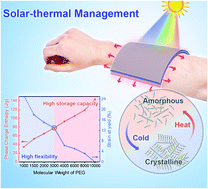Tuning the flexibility and thermal storage capacity of solid–solid phase change materials towards wearable applications†
Abstract
Polyurethane (PU) based phase change materials (PCMs) undergo the solid–solid phase transition and offer state-of-the-art thermal energy storage (TES). Nevertheless, the exploration of these PCMs in real-life applicable smart devices is generally hindered by the technical bottleneck of structural rigidity, low thermal storage capacity and lack of functionalities. Herein, for the first time, we systematically tuned the thermal storage capacity and flexibility of PU-based PCMs (PU-PCMs) by controlling the molecular weight of polyethylene glycol and figured out the optimum selection through the tradeoff between flexibility and thermal storage capacity. We further incorporated functionalized carbon nanotubes (CNTs) in flexible PU-PCMs to improve the thermal conductivity and solar-driven thermal conversion and storage capability. The results demonstrate that the thermal conductivity of the PU–CNT composite is improved by 2.3 times with only 5% weight content of CNTs, and the solar-thermal energy storage efficiency reaches 85.89% at 125 mW cm−2 of irradiation power. Benefitting from the unique mechanical and thermal properties, we further explored our developed composite PCM for solar-driven thermal management of human body parts.



 Please wait while we load your content...
Please wait while we load your content...